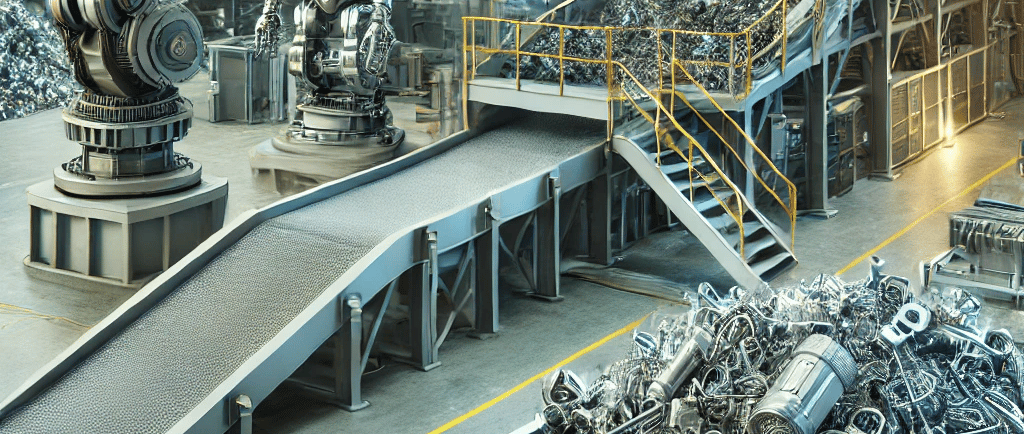The Economic Benefits of Recycling: A Comparison of Ferrous vs. Non-Ferrous Metals
Explore the economic benefits of recycling ferrous and non-ferrous metals. Discover market trends, profitability insights, and future opportunities in the scrap metal industry. Learn how recycling copper, aluminum, and steel can drive revenue, sustainability, and job creation.
METALS INDUSTRY ECONOMICS & MARKET TRENDS


Introduction
Recycling plays a crucial role in the global economy, contributing to job creation, resource conservation, and environmental sustainability. However, not all recycled metals offer the same economic benefits. In the scrap metal industry, the distinction between ferrous and non-ferrous metals significantly impacts profitability, market demand, and overall financial viability.
If you’re involved in the recycling business or considering investing in metals, understanding the economic value of ferrous vs. non-ferrous metals is essential for making informed decisions. This article provides a data-driven analysis of the market demand, profitability, and financial advantages of recycling each metal category, exploring current trends, future opportunities, and sustainability factors that influence the industry.
Understanding Ferrous and Non-Ferrous Metals
Defining Ferrous and Non-Ferrous Metals
Ferrous Metals
These metals contain iron, making them magnetic and prone to rust. Common examples include:
Steel (construction beams, automotive parts, machinery)
Cast iron (pipes, automotive engines, heavy-duty cookware)
Wrought iron (decorative gates, fences, and railings)
Non-Ferrous Metals
These metals do not contain iron, making them corrosion-resistant, lightweight, and more valuable in certain industries. Examples include:
Copper (electrical wiring, plumbing)
Aluminum (aerospace, automotive, packaging)
Brass and bronze (musical instruments, decorative elements, valves)
Precious metals like gold, silver, and platinum (electronics, jewelry, investment products)
Both categories hold tremendous economic value, but their marketability, recyclability, and industry application vary significantly.
Market Demand: How Ferrous and Non-Ferrous Metals Compare
Ferrous Metals: High Quantity, Lower Market Price
Ferrous metals, primarily steel and iron, are in constant demand due to their widespread use in infrastructure and industrial applications.
Pricing Trends and Economic Factors
Scrap steel prices (2024): $200–$400 per ton
Key industries driving demand:
Construction and infrastructure (reinforcement bars, beams, foundational structures)
Automotive manufacturing (frameworks, engine components, body panels)
Household appliances (washing machines, refrigerators, machinery)
Non-Ferrous Metals: Lower Supply, Higher Market Prices
Non-ferrous metals command higher market values due to their industrial importance and relative scarcity.
Current Market Prices (2024)
Copper: $8,500–$9,500 per metric ton
Aluminum: $2,200–$2,500 per metric ton
Gold: Over $2,000 per ounce
High-Growth Industry Applications
Copper: Essential for power transmission, electronics, and battery production.
Aluminum: Used in lightweight automotive solutions, aerospace, and packaging.
Lithium and rare earth metals: Critical for electric vehicles (EVs) and solar panels.
Economic Takeaway
While ferrous metals account for the largest volume in the recycling sector, non-ferrous metals generate higher profits per ton, making them more attractive for long-term investments.
Profitability: Which Metal Group Yields Higher Margins?
Ferrous Metal Recycling: High Volume, Lower Profit Margins
Economic Breakdown of Ferrous Metal Recycling
Processing costs: $20–$50 per ton
Typical profit margins: Low to moderate
Environmental benefits: Recycling steel reduces CO₂ emissions by 58%
Recycling ferrous metals ensures business stability, particularly in sectors such as construction and automotive manufacturing. However, recyclers typically rely on bulk material processing to achieve significant revenue.
Non-Ferrous Metal Recycling: High ROI Business Model
Economic Breakdown of Non-Ferrous Metal Recycling
Processing costs: $100–$500 per ton
Profit margins: High, with potential returns of $1,000 to $5,000 per ton
Market volatility: Greater risk but higher opportunity for strategic trading and investment
Non-ferrous metals retain 100% of their properties when recycled, making them a critical component of sustainable and circular economies.
Economic Takeaway
If maximizing return on investment (ROI) is a priority, focusing on non-ferrous metals—especially copper and aluminum—can generate significantly greater earnings than ferrous metals.
Employment and Economic Growth from Metal Recycling
The scrap metal recycling sector serves as a major economic driver, supporting over 506,000 jobs in the U.S. alone (ISRI, 2023).
Key Employment and Economic Contributions
Non-ferrous metal recycling jobs pay 15–30% more due to the specialized skills required.
The industry contributed over $117 billion to the U.S. economy in 2022.
Approximately 80% of recycled metals are reintegrated into supply chains, reducing reliance on mining.
Economic Takeaway
Investing in metal recycling enhances both financial returns and workforce development, supporting sustainable economic growth.
Future Trends and Opportunities in Metal Recycling
1. Growing Demand for Battery Metals
Copper, lithium, and nickel will play critical roles in electric vehicles (EVs) and renewable energy storage.
2. AI & Automation in Recycling
AI-powered sorting innovations improve efficiency and maximize metal recovery rates.
3. Regulatory Incentives for
Recycling
Governments continue to implement sustainability policies, making recycling more profitable.
Economic Takeaway
Non-ferrous metals—particularly copper, aluminum, and lithium—are expected to experience exponential market growth, creating lucrative opportunities for investors and recyclers alike.
Final Verdict: Which Metal Category is More Economically Advantageous?
When comparing ferrous and non-ferrous metals in terms of economic benefits:
Market Demand: Both ferrous and non-ferrous metals are in high demand, driven by industries such as construction, automotive, and electronics.
Profitability: Non-ferrous metals tend to yield higher profits per ton due to their scarcity and strong industrial applications.
Processing Costs: Ferrous metals generally have lower processing costs, making them more accessible for large-scale recycling businesses.
Recyclability: While both metal types are recyclable, non-ferrous metals retain 100% of their properties, ensuring long-term value.
Market Risk: Ferrous metals offer stability due to their high-volume demand, whereas non-ferrous metals are more volatile but present significant opportunities for high returns.
Which Metal Should You Focus On?
If you prioritize high ROI, investing in non-ferrous metals like copper and aluminum can generate significantly greater earnings.
If you seek business stability, recycling ferrous metals provides consistent revenue with lower financial risk.
Either way, metal recycling remains a lucrative, future-proof industry, contributing to a more sustainable global economy.
